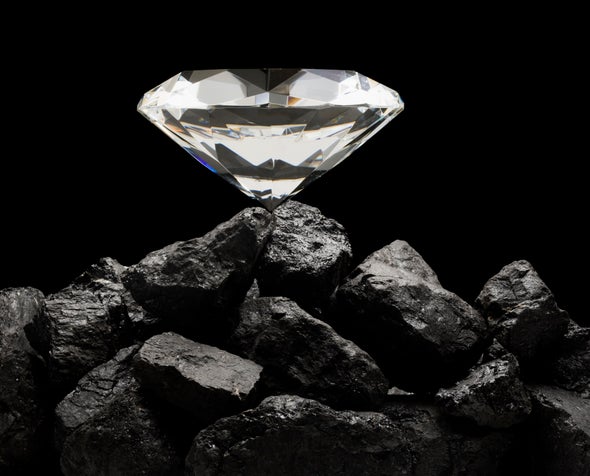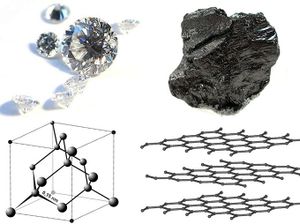Back to: CHEMISTRY SS1
Welcome to class!
In today’s class, we will be talking about carbon and its properties. Enjoy the class!
CARBON AND ITS PROPERTIES

CONTENT
- Occurrence and Allotropes
- Properties
OCCURRENCE
- It occurs naturally as diamond and graphite.
- It occurs in an impure form as coal.
- It occurs in the combined state as petroleum, wood and natural gases.
- It occurs in minerals such as limestone (CaCO3) and dolomite (MgCO3)
- It occurs in the atmosphere (air) as CO2
- It is an essential constituent of all forms of plant and animal life.
ALLOTROPES OF CARBON
Allotropy is the phenomenon whereby an element exists in two or more different forms in the same physical state. The different forms of the elements are known as allotropes. They have the same chemical properties but different physical properties.
Carbon exists in several allotropic forms:
(1). Crystalline Allotropes e.g. Diamond and graphite
(2). Non-crystalline Allotropes/Amorphous carbon e.g. coal, charcoal, coke, lampblack and carbon black (soot)
CRYSTALLINE ALLOTROPES OF CARBON
Diamond: Diamond is the purest form of carbon. The diamond crystal is octahedral in shape. It is a giant molecule in which the carbon atoms are closely packed and held together by strong covalent bonds.

Basic Tetrahedral Shape in Diamond Crystals
PROPERTIES OF DIAMOND
(1) Diamond is extremely hard and strong with a high melting point because of a strong covalent bond. Diamond is the hardest substance known in the world.
(2) It has a high density because of its compactness of crystal.
(3) It is very resistant to chemical action and temperature because all four valence electrons are saturated bonded.
(4) It is a non-conductor of electricity because there are no free valence electrons in the crystal lattice.
(5) Transparent and highly refractive, hence it is used as a jewel and sparkling substance.
USES OF DIAMOND
(1) They are used industrially in drills for in mining since they are dense and hard.
(2) They are used to sharpen very hard tools.
(3) They are used for cutting glass and metals.
(4) They are also used as pivot supports in precision instruments and as dies for drawing wires
(5) It is valuable in making jewellery (i.e. its high refractive index and dispersion power give it a sparkling brilliance when it is cut and polished).
Artificial diamond: They are made by subjecting graphite to a very high temperature and pressure for several hours in the presence of nickel or rhodium catalyst.
GRAPHITE: The graphite crystal is hexagonal in shape. The carbon atoms in graphite form flat layers. These layers are arranged in parallel, one above the other to form a crystal lattice.

PROPERTIES OF GRAPHITE
(1) Graphite is soft and slippery because of weak forces holding its layers. Each layer can slide over one another. Hence, graphite acts as a lubricant.
(2) It is less dense and prone to chemical attack due to its open structures in layers.
(3) It is a good conductor of electricity because of the presence of free delocalized electrons (mobile electron) in the crystal lattice.
(4) It is inert and used to absorb radiations in a nuclear station in the atomic pile.
USES OF GRAPHITE
(1) It is usually used on bicycle chains and for the bearings of some motor cars.
(2) It is used as a non-greasy lubricant (i.e combining it with oil makes a high-temperature lubricant).
(3) It is used as electrodes in electroplating and dry cells (since it is a good conductor of electricity and relatively inert).
(4) Graphite can be used to make a non-conductor conductive by coating with it.
(5) It is used to line crucibles for making high-grade steel and other alloys (since it can withstand high temperature).
(6) It is used in making lead pencils i.e. combining it with clay makes the lead in pencils.
(7) It is used as a black pigment in paints.
(8) It is used as a neutron moderator in atomic piles.
INDUSTRIAL PREPARATION OF GRAPHITE
Graphite is produced industrially by heating coke in an electric furnace to a very high temperature for about 20 to 30 hours. This process is called the Acheson process. Acheson process is a process of producing graphite from coke at high temperature. Air is excluded by covering the coke with sand. The graphite produced is very pure and free from grit.
DIFFERENCES IN PROPERTIES BETWEEN GRAPHITE AND DIAMOND
| Graphite | Diamond |
| 1. It has a density of 2.3gcm-3 | 1. It has a density of 3.5gcm-3 |
| 2. It is a black, opaque solid | 2. It is a colourless, transparent solid |
| 3. It is very soft, marks paper | 3. It is the hardest known substance. |
| 4. It is a good conductor of electricity | 4. It is a non-conductor of electricity |
| 5. Attacked by potassium trioxochlorate (v) and trioxonitrate (v) acid together. | 5. Not attacked by these reagents. |
Note: Diamond is transparent to x-rays while the glass is almost opaque.
AMORPHOUS CARBON
Carbon also occurs in many other forms which has no definite crystalline structure. These non-crystalline structures which are not considered to be true allotropes include:
CHARCOAL: This is made by burning wood, bones, sugar etc in a limited amount of air. Charcoal is used to remove the colour from substances. Wood charcoal is used in absorbing poisonous gases while animal charcoal is used in absorbing colours.
CARBON BLACK AND LAMP BLACK: Lamp black is obtained by burning the wick of an oil lamp excessively so that it leaves a deposit of soot on the lamp-glass and cover; while carbon black is obtained from burning coal gas, natural gas or petroleum. Carbon black and lampblack are used as an additive to rubber tyres. They are also used in making printer’s ink, carbon paper, black shoe polish, typewriting ribbons e.t.c
PHYSICAL PROPERTIES OF CARBON
(1) All the different allotropes of carbon are black or greyish-black solids except diamond and they are odourless and tasteless.
(2) They have a high melting point of about 35000C.
(3) They are insoluble in all common solvents like water, alkalis, acids, petrol and carbon (iv) sulphide (CS2). This is the reason carbon deposits inside motor engines have to be removed mechanically. This is known as decarbonisation of motor engines.
CHEMICAL PROPERTIES OF CARBON
(1) Combustion:
(a) All forms of carbon burn in excess oxygen to produce carbon (iv) oxide gas.
C(s) + O2(g) → CO2(g) ( Complete combustion)
(b) All forms of carbon also burn in a limited supply of air to produce carbon (ii) oxide.
C(s) + O2(g) → CO(g) ( Incomplete combustion)
(2) Combination reaction:
Carbon combines directly with certain elements such as Sulphur, Hydrogen, Calcium and Aluminium at very high temperatures.
- C(s) + 2S(s) → CS2(l)
Carbon (iv) sulphide
- C(s) + 2H2(g) → CH4(g)
Methane
- 2C(s) + Ca(s) → CaC2(s)
Calcium carbide
- 3C(s) + 4Al(s) → Al4C3(s)
Aluminium carbide.
(3) As a reducing agent:
Carbon is a strong reducing agent. It reduces the oxides of the less active metals to the metals, while carbon is itself oxidized to either carbon (iv) oxide or carbon (ii) oxide, depending on the reaction conditions.
Fe2O3(s) + 3C(s) → 2Fe(s) + 3CO(g)
2CuO(s) + C(s) → 2Cu(s) + CO2(g)
H2O(g) + C(s) → CO(g) + H2(g)
CO2(g) + C(s) → 2CO(g)
K Na Ca Mg Al Zn Fe Sn Pb H
Cu Hg Ag Au
The oxide is not reduced The oxide is reduced to the metal when
when heated heated
ZnO(s) + C(s) → Zn(s) + CO(g)
PbO(s) + C(s) → Pb(s) + CO(g)
(4) Reaction with strong oxidizing agents: When carbon is heated with conc. HNO3 or conc. H2SO4, it is oxidized to Carbon (iv) oxide.
C(s) + 4HNO3(aq) → 2H2O(l) + 4NO2(g) + CO2(g)
C(s) + 2H2SO4(aq) → 2H2O(l) + 2SO2(g) + CO2(g)
WEEKEND ASSIGNMENT
- The existence of an element in two or more form in the same physical state is known as a. allotropy b. isotopy c. isomerism d. hybridization.
- The equation Fe2O3(s) + 3C(s) → 2Fe(s) + 3CO(g) a. is oxidation reaction of carbon b. reduction reaction of carbon. c. carbonization of Fe2O3 d. destructive distillation of Fe2O3.
- Which of the following correctly describes the structure of graphite? a. ionic lattice b. network structure c. molecular solid d. layer lattice.
- Carbon is often deposited in the exhaust pipe of cars because of a. dehydrogenation of petrol b. incomplete combustion of petrol c. presence of additives in petrol d. presence of carbon in petrol.
- Graphite and diamond are allotropes of Carbon but only graphite conducts electricity because graphite a. is tetrahedral while diamond is octahedral in shape b. contains mobile ions but the diamond does not c. is soft but the diamond is hard d. contains free electrons but the diamond does not.
THEORY
- Mention the respective properties of the following allotropes of carbon that account for their uses as indicated (a) Diamond used for drilling rock (b) Diamond used as a jewel (c) Graphite used for slowing down neutrons in nuclear reactors. (d) Graphite used as electrode
- (a) State one evidence that shows that both graphite and diamond are allotropes. (b) Give reasons why graphite is soft and diamond, its allotrope is hard.
In our next class, we will be talking about Oxide of Carbon. We hope you enjoyed the class.
Should you have any further question, feel free to ask in the comment section below and trust us to respond as soon as possible.

This is quite helpful. I really love reading from you guys… Good job!